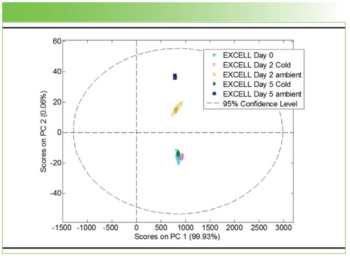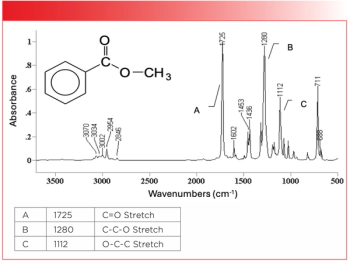
Tutorial Review: The use of the OH stretching bands of water in biomedical applications of Raman spectroscopy
This is a brief tutorial review on the use of the Raman OH stretching bands of water for biomedical applications.
Abstract
This review outlines the usefulness of the OH stretching bands of water in the 3800-3200 cm-1 region in probing in situ water content and functions in tissues and organs. Using the OH stretching bands of water one can probe the progress of diseases and explore the physiological conditions in tissues. Raman investigations on eye lenses, cornea, brain tissues, and skin tissues are described as examples in this review.
Introduction
Raman scattering of water is weak, and thus Raman spectroscopy is suitable for biological and biomedical applications (1,2). Since the 1970s Raman spectroscopy has been applied extensively to various biological molecules, cells, tissues, and organisms to investigate their structures and functions (1-3). Raman spectroscopy has the following advantages. It is a nondestructive analysis method, and it is possible to obtain molecular structural information from Raman spectra. One can also use a light fiber for Raman measurement. In this review we demonstrate positive uses of an intense water bands in the 3800-3100 cm-1 region (4) using several interesting examples (5-11). This sort of studies are rather rare but we have employed the OH stretching bands of water to monitor the progress of diseases and investigate the physiological conditions in tissues (5-11). We introduce Raman studies on eye lenses (5-8), cornea (9), brain tissues (10), and skin tissues (11) as examples in this review.
Raman spectra of pure water
The Raman spectra in the 4000-3000 cm-1 region of water and aqueous solutions show a very broad feature centered at around 3300 cm-1(4). Using the second derivative one can divide the broad feature into two major bands at 3400 and 3220 cm-1. It is well known that these are due to OH stretching modes of weakly hydrogen-bonded (WHB) water species and strongly hydrogen-bonded (SHB) water species, respectively. SHB and WHB water species have tetrahedron structure and slightly distorted tetrahedron structure, respectively (4).
Raman studies of lens aging and cataractgenesis
Ozaki et al. (2,5-8) investigated cataractgenesis nondestructively using Raman spectroscopy. Their studies may be the first examples of applications of Raman spectroscopy to explore disease mechanism. Figure 1 shows Raman spectra of rabbit lenses (nucleus center, one month and five years old) (5). A broad feature in the 3800-3100 cm-1 region is due to OH stretching modes of water in the lenses, and bands in the 3100-2800 cm-1 region are assigned to CH stretching modes of lens proteins, Weak bands at 2579 and 2561 cm-1 are ascribed to SH stretching modes of cysteine residues of the proteins. The existence of the two bands at 2579 and 2561 cm-1 indicate that there are two kinds of cysteine residues having hydrogen bonds with different strength.
The broad water feature contains bands derived from free water and bound water. Two band maxima at 3390 and 3280 cm-1 may be ascribed to the OH stretching modes of weakly hydrogen bonded (WHB) and strongly hydrogen bonded (SHB) water species, respectively. Ozaki et al (6,7) used the relative intensity of the bands at 3390 and 2935 cm-1 to monitor the changes in water content during lens aging and cataractgenesis.
Figure 1: Raman spectra of rabbit lenses (nucleus center, one month and five years old). Experimental Conditions: excitation wavelength; 514.5 nm, laser power ; 200 mW, Spectral resolution; 4 cm-1.Reproduced from reference (5) with permission.
It is noted in Figure 1 that the intensities of bands due to water become weak significantly with lens aging, suggesting that the water content in the eye lenses decreases as the lens ages (5). This study revealed that one can monitor water content in situ by Raman spectroscopy.
Figure 2:(a) and (b) Age-dependent Raman spectral variations in the 3800-2800 and 2800-2500 cm-1 regions of SD-strain rat lens nuclei, respectively. Experimental conditions for the spectra in Figure 2-5 were almost the same as those in Figure 1.Reproduced from reference (6) with permission.
Figure 3: (a) and (b) The intensity ratio of the two bands at 2579 and 2731 cm-1and that of the two bands at 3390 and 2935 cm-1, respectively. Reproduced from reference 6 with permission.
Age-dependent Raman spectral changes in the 3800-2800 and 2800-2500 cm-1 regions of SD-strain rat lens nuclei are exhibited in Figure 2a and 2b, respectively. The relative intensity of the two bands at 3390 and 2935 cm-1 decreases with aging, showing that the water content in the lens decreases with lens aging.The relative intensity of the two bands at 2579 and 2731 cm-1 also decreases with time.It is very likely that some cysteine residues in the lens proteins form S-S linkages as the lens ages. Figure 3a and 3b plot age-dependent changes of the intensity ratio of the two bands at 2579 and 2731 cm-1and that of the two bands at 3390 and 2935 cm-1, respectively (6). Interestingly enough both intensity ratios decrease almost in parallel to each other, showing that the formation of S-S bonds proceed with the decrease of water content.
Raman spectra in the 1800-400 cm-1 region of lenses (Figure 1) are typical protein spectra, showing many bands such as those arising from Amide I, Amide III, and amino acid residues such as tyrosine, tryptophane and phenylalanine. The Amide I band at 1671 cm-1 and the Amide III bands in the 1300-1210 cm-1 region do not show significant changes between the two spectra in Figure 1, suggesting that protein secondary structure varies little in the aging process.
Ozaki et al. (7,8) explored the formation of cataract at the molecular level in vivo using Raman spectroscopy.Both cac-strain mouse cataract (7) and Emory mouse cataract (8) were subjected to Raman investigations. The cac-strain mice possess a hereditary defect in the lens; a cataract appears in the nuclear portion of the lens approximately 3 weeks after birth, and nuclear opacity is completed within in a few weeks (7). Emory mouse cataract is a late appearing hereditary cataract (8). The lens nuclei of Emory mouse cataract were clear until about 5 months after birth, but they became hazy about 6 months after birth, and then became lightly opaque after about 7 months. Figure 4 shows Raman spectra in the 950-700 cm-1 region of Emory mouse lens nuclei (36 days old clear and 7.5 month old lightly opaque lenses).Two bands at 855 and 832 cm-1 are due to tyrosine residues of lens proteins. It is noted in Figure 4 that the intensity ratio of the two bands (tyrosine doublet) varies clearly with the cataract formation (8). A similar change was also observed for the cac-strain mouse cataract (7). It is well known that the relative intensity of tyrosine doublet is very sensitive to the microenvironment of a tyrosine residue. Therefore, the results suggest that some buried tyrosine residues become exposed with protein aggregation during the formation of cataract (7,8).
Figure 4:Raman spectra in the 950-700 cm-1 region of Emory mice lens nuclei (36 days old clear and 7.5 months old lightly opaque lens nuclei). Reproduced from reference 8 with permission.
Figure 5 shows Raman spectra in the 3800-2800 cm-1 region of Emory mice lens nuclei (41 days, 6- and 8-months) (8). The lens nuclei in the 41 days, 6- and 8-months were clear, hazy, and lightly opaques, respectively. The intensity of water band decreases upon going from the 41 days to the 6 months, and then, reversely it increases from the 6 months to the 8 months (8). It can be seen from the first decrease that the water content decreases with aging as in the case of ICR-strain mice lens nuclei while the following increase indicates that the water content increases with the development of cataract. It is well known that for many kinds of cataracts the break of the balance of water efflux and influx through the lens membrane initiates a series of physicochemical events that ultimately lead to lens opacification (8).
Figure 5: Raman spectra in the 3800-2800 cm-1 region of Emory mice lens nuclei (41 days old clear, 6-months old hazy, and 8-months old lightly opaque). Reproduced from reference 8 with permission.
Raman study of normal cornea and drug-treated cornea
Erekens et al. applied the idea of using the intensity ratio of OH stretching band of water and CH stretching band of proteins for probing in vivo the water contents in normal and drug-treated corneas.Figure 6 exhibits a series of Raman spectra in the CH and OH stretching band regions of normal cornea (a) and drug-treated cornea (b) measured as a function of probing depth into the cornea (9). The spectra were obtained along the axis of the cornea by a confocal Raman spectrometer. Figure 6 suggests that hydration in the cornea changes with the depth and that the drug affects it significantly.
Figure 6: A series of Raman spectra in the CH and OH stretching band region of normal cornea (a) and drug-treated cornea (b) obtained as a function of probing depth into the cornea. Reproduced from reference 9 with permission.
Water content and water structure in brain tissue studied by Raman spectroscopy
Sato et al. (10) succeeded in measuring Raman spectra of brain tissues of live mice and rats using a miniaturized Raman probe. The use of a ball lens hollow fiber Raman probe (BHRP) (1,2) and a background-free electronically tuned Ti:sapphire laser enabled the measurement of high-quality Raman spectra of the brain tissue. The Raman measurements were carried out for the animal under anesthesia by sodium pentobarbital (SP), after inhalation of diethyl ether (DE) vapor, and after euthanasia. It was found from the spectra in the OH stretching band region that water concentration and water cluster conformation change with changes in the conditions of the animal, and the changes are site-dependent in the brain.
The BHRP used to measure Raman spectra comprises a single hollow fiber and a ball lens attached to its distal end. The length of the BHRP is 1.5 m, and its maximum diameter is 640 mm. The spectral resolution of the Raman system was typically less than 10 cm-1.
Figure 7: (a) The structure of the skull of mouse and its Raman measurement sites. (b) Holes were made on the skull such that blood vessels were avoided. (c) The tip of the BHRP gently touched the surface of the brain to measure the spectra. Reproduced from reference (10) with permission.
Figure 8: Raman spectra of frontal cortex of a mouse brain (A) in the fingerprint region and (B) high-wavenumber region. The spectra were measured (a) when the animal was under anesthesia by SP, (b) when the animal inhaled DE vapor, and (c) after the animal was euthanized. The band indicated by the asterisk mark is attributed to the oxygen in the air in the hollow fiber. Two excitation wavelenghs-785 and 720 nm-were used to measure Raman spectra in the finger print region and the higher frequency region , respectively.The laser power at the sample point were about 40 and 15 mW, respectively. The exposure time was 300 s. Reproduced from reference (10) with permission.
The skull was exposed, and a small hole was drilled at the sites shown in Figure 7 in order to insert the BHRP (10).Figure 8 shows Raman spectra of frontal cortex of a mouse brain (a) in the fingerprint region, and (b) in the high-wavenumber region (10). The spectra were measured (a) when the animal was under anesthesia by SP, (b) when the animal inhaled DE vapor, and (c) after the animal was euthanized. Judging from the working distance of the BHRP and the focal depth, it was suggested that the Raman spectra of the brain are obtained from the brain tissue located approximately 20–40 μm beneath the brain surface. Bands at 1664, 1446, and 1003 cm-1 are assigned to the amide I mode, CH2 bending mode, and a breathing mode of phenylalanine of the protein species, respectively. Amide III bands are identified at 1344, 1301, and 1268 cm-1. It is well known that the Raman signals of lipid species are generally significantly stronger than those of the proteins, and thus, the lack of a band at 718 cm-1 due to phospholipids indicates that the measured tissue in the frontal cortex is rich in proteins and its lipid content is very low.
Bands at 2928, 2881, and 2846 cm-1 in Spectra (B) are assigned to the CH stretching modes of the proteins and lipids. Broad bands at 3397 and 3297 cm-1 are due to the OH stretching modes of water molecules. A band due to the NH stretching mode of the amide groups at 3293 cm-1 appears to overlap with the band due to water (6). To analyze minor spectral changes in Figure 8, subtracted spectra were calculated and shown in Figures 9a and 9b (10). The spectra denoted by (d) and (e) are subtraction results of spectra (b)-(a) and (c)-(a) shown in Figure 8a and 8b, respectively. Spectra (d) and (e) in the fingerprint region (Figure 9a) have no bands, suggesting that the basic molecular structure and composition of tissue materials, including the conformation of proteins in the brain, do not change, even by the death of the animal. Broad bands in the high-wavenumber region of Spectra (d) and (e)(Figure 9b) are due to the OH stretching bands of water. Spectrum (d) shown in Figure 9b reflects the effect of inhalation of DE vapor, suggesting that DE affects the conformation of water clusters in the brain tissue. The ratio of the intensity of the band in spectrum (d) to the intensity of the original band due to water in the tissue is 2.8%. A similar spectral change is observed in the spectrum of NSS to which DE is added. Figure 10a shows a Raman spectrum of NSS, Spectrum (b) in Figure 10 is the difference spectrum between the spectrum of only NSS and the spectrum of DE-added NSS; spectrum (b’) is the enlarged spectrum of Spectrum (b) (10). Bands at 2986, 2939, and 2880 cm-1 in Spectrum (b) are due to the CH stretching modes of DE. The band at 3453 cm-1 due to WHB water species indicates that some conformational change of the water clusters from SHB to WHB species occurs by the addition of DE. It is likely that DE, which can pass through the blood–brain barrier, enters the brain tissue and affects the structure of water clusters, although the concentration of DE in the tissue is considerably lower than that in the normal saline-DE solution. Figure 9e reflects the effect of death of the animal. The OH stretching band of water is so broad that the band seems to contain contributions both from WHB and SHB species. The intensity of the water band decreases by approximately 7.7%. The spectral feature of the water band in Spectrum (e) shows good agreement with the features of the spectrum of the NSS. The decrease in water concentration observed in the cerebral cortex may simply indicate a reduction in blood flow associated with physical brain death. If that were the case, a similar reduction in water content should be observed in other parts of the brain. However, in reality, no decrease in water concentration was observed in the olfactory bulb. This suggests that the changes in water concentration are related to a decline in brain function, rather than brain death (10). There still remains one possibility that the reduction in the water concentration is the result of the termination of blood flow.
Figure 9: Subtracted Raman spectra of frontal cortex of a mouse brain in the fingerprint region (A) and high-wavenumber region (B). Resultant subtracted spectra of the spectrum measured under anesthesia from that measured under the inhalation of DE (d) and from that measured after euthanasia (e). Spectrum (f) is the subtraction result of spectra measured twice after anesthesia. Reproduced from reference (10) with permission.
Figure 10: (a) A Raman spectrum of NSS. (b) Resultant subtracted spectrum of NSS spectrum from spectrum of NSS + DE. (c) Partial enlarged spectrum of Spectrum (b) (20 x ; b’ ). Reproduced from reference (10) with permission.
The study clearly showed that Raman spectroscopy with the BHRP is very useful for exploring brain function on the basis of the molecular composition and structural changes in the tissue materials probed by the OH stretching bands (10). Variations in water concentration and its cluster conformation were observed by the inhalation of DE vapor and the euthanasia of the animal. The inhalation of DE vapor causes an increase in certain water clusters in the brain tissues while the death of the animal caused a decrease in the water concentration in the frontal cortex and an increase in the water concentration in the olfactory lobes.
Raman study of water content in skin—In Vivo human skin measurement
Egawa et al. applied spontaneous Raman scattering spectroscopy formolecular sensing of skin components without a chemical pretreatment (11-15). The first study in vivo Raman measurement of water in human skin was reported by Puppels et al. in 2000 (16). In the next year the same group reported a calculated algorithm of the depth distribution of components, including water, lipids, and amino acids (17). Figure 11 shows the spontaneous Raman scattering spectra in the high wavenumber region collected by backscattered light of human skin in vivo at depths of 0–10 µm from the skin’s surface with the auto-fluorescence offset (12). The skin is a highly scattering material, and thus, accurate quantification of a component is determined only with considering the attenuation of the irradiating and scattered light in the skin. Note that even though the irradiating laser is near-infrared, the signal/noise ratio (S/N) of the fingerprint spectrum is often poor because autofluorescence from the skin contributes to interference (12).
Figure 11: Spontaneous Raman scattering spectra of human skin in 4600-2600 cm-1 region. The spectra obtained at different depths in the skin: 0 to 10 µm from the skin surface. Reproduced from reference (12) with permission.
Several studies (18-20) reported the depth distribution of skin components using spontaneous Raman scattering microscopy in vivo with the algorithm proposed by Caspers and Puppels et al.(18) Egawa et al. also reported results on the depth distribution of skin components in the stratum corneum obtained in vivo, especially targeting water and water-related components (11-15). Specifically, we measured the site difference in the water depth distribution from the skin surface (14) and the change in the water depth distribution in the skin after applying water to the skin surface using cotton (15). They also investigated the water depth distribution in each part of the body.
Egawa and Kano et al. measured depth-resolved water imaging of skin using CARS to visualize the distribution of water concentration in human skin ex vivo (21). Figure 12 displays CARS images of upper part of epidermis at (a) 2930 cm-1 (CH stretching of intercelluler lipids), (b) 3476 cm-1 (OH stretching mode of water), and (c) 3476 cm-1/ 2930 cm-1 (21). Egawa and Kano et al. demonstrated the potential of CARS spectroscopic imaging for probing pathological changes by anomalous water concentration distribution in human skin.
Figure 12: Depth-resolved water imaging of skin using CARS. CARS images of upper part of epidermis at (a) 2930 cm-1, (b) 3476 cm-1, and (c) 3476 cm-1/ 2930 cm-1. Reproduced from reference (21) with permission.
Perspective
Whiskey that has been aged for many years has a smoother taste compared to newer ones. General anesthesia and drunkenness are caused by small molecules like ethanol and ether that can pass through the blood-brain barrier, and the receptors for these are not found in nerve cells. Various phenomena have suggested the relationship between water and sensory organs, namely the nervous system, for a long time. However, a clear answer is still unknown. Water molecules are too small to label, and the exchange of molecules happens too quickly, making it difficult to track specific molecules. Therefore, there has been a need for analytical techniques that allow for unlabelled analysis and statistical analysis of molecular behavior to study water in vivo. That is to say, an analytical technique that allows for label-free analysis and the statistical analysis of molecular behavior has been needed for the analysis of water in biological systems. The analysis techniques using Raman spectroscopy for biological tissues and live cells are considered suitable for correlational analysis of biological functions and water. MRI is a representative non-invasive analytical device that analyzes water in the body, but it has low spatial resolution and cannot perform cell-level analysis. With the development of Raman spectroscopy and chemometrics, not only can the role of water molecules be clarified, but detailed analyses of brain functions can also be performed in conjunction with analytical techniques such as MRI. This is expected to lead to new insights into diseases related to brain function disorders, including Parkinson's disease, which involves the nervous system.
References
(1) Matousek, P.; Morris, M. D. Emerging Raman Applications and Techniques in Biomedical and Pharmaceutical Fields; Springer: 2010.
(2) Sato, H.; Popp, J.; Wood, B.; Ozaki, Y. Raman Spectroscopy in Health Science and Biomedicine; World Scientific: 2024.
(3) Lasch, P.; Kneipp, J. Biomedical Vibrational Spectroscopy; Wiley: 2008.
(4) Asano, H.; Ueno, N.; Ozaki, Y.; Sato, H. Temperature-Dependent Structural Variations of Water and Supercooled Water and Spectra Analysis of Raman Spectral of Water from the OH-Stretching Band Region and Low-Frequency Region Studies by Two-Dimensional Correlation Raman Spectroscopy. J. Raman Spectrosc. 2022, 53, 1669–1678. DOI:
(5) Ozaki, Y.; Mizuno, A.; Kamada, Y.; Itoh, K.; Iriyama, K. Laser Raman Spectroscopic Study of a Diabetic Cataract. Chem. Lett. 1982, 11, 887–890.
(6) Ozaki, Y.; Mizuno, A.; Itoh, K.; Yoshiura, M.; Iwamoto, T.; Iriyama, K. Raman Spectroscopic Study of Age-Related Structural Changes in the Lens Proteins of an Intact Lens. Biochemistry 1983, 22, 6254–6259.
(7) Itoh, K.; Ozaki, Y.; Mizuno, A.; Iriyama, K. Structural Changes in Lens Proteins of Hereditary Cataract Monitored by Raman Spectroscopy. Biochemistry 1983, 22, 1773–1778.
(8) Ozaki, Y.; Mizuno, A.; Itoh, K.; Matsushima, S.; Iriyama, K. Raman Spectroscopic Study of Cataract Formation: Emory Mouse Cataract. Appl. Spectrosc. 1982, 41, 597–605. DOI:
(9) Erekens, R. G.; Jongsma, F. H. M.; Wicksted, J. P.; Hendrikse, F.; Motamedi, M. Drug-Induced Corneal Hydration Changes Monitored In Vivo by Non-Invasive Confocal Raman Spectroscopy. J. Raman Spectrosc. 2001, 32, 733–737.
(10) Sato, H.; Yamamoto, S. Y.; Maruyama, A.; Katagiri, T.; Matsuura, Y.; Ozaki, Y. Raman Study of Brain Functions in Live Mice and Rats: A Pilot Study. Vib. Spectrosc. 2009, 50, 125–130. DOI:
(11) Egawa, M. In Raman Spectroscopy in Health Science and Biomedicine; Sato, H., Popp, J., Wood, B., Ozaki, Y., Eds.; World Scientific: 2024; pp 173–200.
(12) Egawa, M.; Haze, S.; Gozu, Y.; Hosoi, J.; Onodera, T.; Tojo, Y.; Katsuyama, M.; Hara, Y.; Katagiri, C.; Inoue, N.; Furukawa, S.; Suzuki, G. Evaluation of Psychological Stress in Confined Environments Using Salivary, Skin, and Facial Image Parameters. Sci. Rep. 2018, 8, 8264. DOI:
(13) Egawa, M. Raman Microscopy for Skin Evaluation. Analyst 2021, 146, 1142–1150. DOI:
(14) Kabashima, K.; Honda, T.; Ginhoux, F.; Egawa, G. The Immunological Anatomy of the Skin. Nat. Rev. Immunol. 2019, 19, 19–30. DOI:
(15) Egawa, M.; Hirao, T.; Takahashi, M. In Vivo Estimation of Stratum Corneum Thickness from Water Concentration Profiles Obtained with Raman Spectroscopy. Acta Derm. Venereol. 2007, 87, 4–8. DOI:
(16) Caspers, P. J.; Lucassen, G. W.; Bruining, H. A.; Puppels, G. J. Automated Depth-Scanning Confocal Raman Microspectrometer for Rapid In Vivo Determination of Water Concentration Profiles in Human Skin. J. Raman Spectrosc. 2000, 31, 813–818.
(17) Caspers, P. J.; Lucassen, G. W.; Carter, E. A.; Bruining, H. A.; Puppels, G. J. In Vivo Confocal Raman Microspectroscopy of the Skin: Noninvasive Determination of Molecular Concentration Profiles. J. Invest. Dermatol. 2001, 116, 434–442. DOI:
(18) Pudney, P. D. A.; Bonnist, E. Y. M.; Caspers, P. J.; Gorce, J.-P.; Marriot, C.; Puppels, G. J.; Singleton, S.; van der Wolf, M. J. G. A New In Vivo Raman Probe for Enhanced Applicability to the Body. Appl. Spectrosc. 2012, 66, 882–891. DOI:
(19) Franzen, L.; Windbergs, M. Applications of Raman Spectroscopy in Skin Research—From Skin Physiology and Diagnosis up to Risk Assessment and Dermal Drug Delivery. Adv. Drug Deliv. Rev. 2015, 89, 91–104. DOI:
(20) Richters, R. J. H.; Falcone, D.; Uzunbajakava, N. E.; Varghese, B.; Caspers, P. J.; Puppels, G. J.; van Erp, P. E.; van de Kerkhof, P. C. Sensitive Skin: Assessment of the Skin Barrier Using Confocal Raman Microspectroscopy. Skin Pharmacol. Physiol. 2017, 30, 1–12. DOI:
(21) Kaneta, D.; Leproux, P.; Couderc, V.; Goto, M.; Egawa, M.; Kano, H. Visualization of Water Concentration Distribution in Human Skin by Ultra-Multiplex Coherent Anti-Stokes Raman Scattering (CARS) Microscopy. Appl. Phys. Express 2021, 14, 042010. DOI:
About the Authors
Yukihiro Ozaki received his PhD from Osaka University in 1978 and held research and academic positions in Canada and Japan before becoming a professor at Kwansei Gakuin University, where he is now professor emeritus and university fellow. He is also a guest professor at Kobe University and a guest principal researcher at RIKEN. Widely recognized for his impactful work in vibrational spectroscopy, Ozaki has made important contributions to Raman, infrared, and near-infrared (NIR) spectroscopy, including advancements in surface-enhanced Raman scattering (SERS), quantum chemical calculations, and two-dimensional correlation spectroscopy. His research has found applications in nanomaterials, biology, and medical diagnostics. He has received numerous honors, including the Bomem-Michelson Award, the Medal with Purple Ribbon, and the Ellis R. Lippincott Award (2025), and is a fellow or member of several prominent scientific societies. The author may be contacted at yukiz89016@gmail.com.
Hidetoshi Sato is a professor in the School of Biological and Environmental Sciences, Kwansei Gakuin University. He obtained his Ph.D. degree in Prof. Yukihiro Ozaki's laboratory, Kwansei Gakuin University, in 1997. He worked at RIKEN, Japan, and became a research unit leader. He moved to Kwansei Gakuin University in 2009.
Newsletter
Get essential updates on the latest spectroscopy technologies, regulatory standards, and best practices—subscribe today to Spectroscopy.





